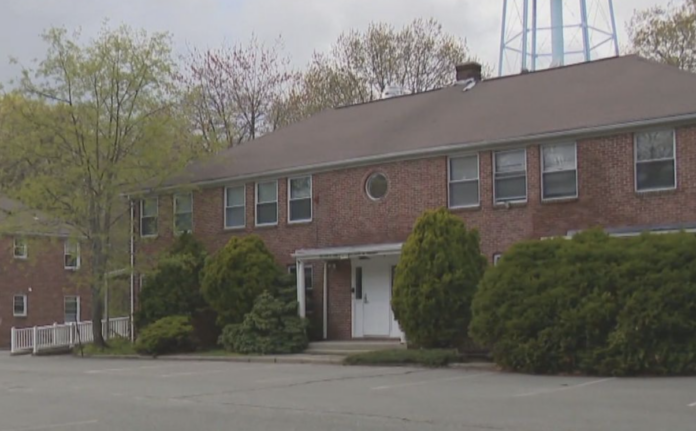BURRILLVILLE – A facility providing living space for dozens of unhoused Rhode Islanders over the past year and a half will close its doors on Monday, June 30, according to the state Department of Housing.
The Tri-County Community Action Agency family campus at Zambarano Hospital is slated to close once a lease on the cottages used for the shelter runs out, an official from the department said in a statement on the matter.
The facility, which opened in October of 2023, features space for around 50 people, and has reportedly served as living quarters for at least 25 children in recent months.
Keyara Kay-Mitchell and her two daughters, ages 1 and 14, are among the facility’s current occupants.
“I am absolutely heartbroken and terrified what the future holds,” said Kay-Mitchell, who noted she received news of the planned closing on Monday, April 21 from campus Director Ehren Hunt.
Situated inside three previously vacant structures on the sprawling Zambarano hospital grounds, the family shelter includes several small apartments in one building, and another with one-room emergency housing units, similar to dorm rooms. The third building holds a community room, where residents have access to a shared kitchen as well as counseling services.
The shelter, operated by the Johnston-based non-profit Tri-County, employs a staff of 14, with two people on site around the clock, as well as three case managers. Previously, the cottages had been used by Phoenix House for substance-abuse recovery for adolescents and teens, and also served as space for quarantine during the pandemic.
But the decision to locate such emergency housing units in Burrillville has been somewhat controversial from the start, with local leaders questioning if its clients would be best served in an area of the state with better access to services. Town Council President Donald Fox has been among those to express concern about costs, pointing to the difficulty of transporting students living on the campus back to their home districts from the state’s most northwest corner, as required under federal law.
Recently, the Burrillville Town Council and School Committee sent a joint letter to Rhode Island Department of Housing Program Development Chief Benjamin Haynie noting that transportation costs for students living in the shelter were totaling from $25,000 to $40,000 a month – an unsustainable expense for the small school district. The town received a $75,000 grant for the expense through the state’s Municipal Homelessness Support Initiative, but school officials have noted that some of the children in the shelter also require special education, an additional cost that typically exceeds $75,000 per student.
Supt. Michael Sollitto told NRI NOW on Wednesday that the district’s estimated cost for transportation of all homeless students – both housed at Zambarano and elsewhere – is anticipated at around $325,000 for the current fiscal year. Of the total, he said about $250,000 is a direct result of transportation costs for Zambarano residents.
“To date, we have not received any relief other than the $75,000 from the state and the additional funds that were insignificant when compared to the total cost,” he said, noting that the expenses are split between the sending and receiving districts, and that his figures only account for Burrillville’s share. “We have reached out to several state officials and state agencies about this and even met with Governor McKee and Housing Secretary Goddard.”
Kay-Mitchell said she was told that the planned closing comes as a result of the facility’s lease not being renewed.
“There are no plans for any families’ alternative placements at this time,” she said.
She believes much of the opposition to the facility has been based on a misunderstanding of the population it serves, noting that she’s often seen locals referred to the occupants as “outsiders.”
“I’m a long term resident of this town,” she said, noting that her older child has attended the Burrillville School District for the majority of her academic career.
A single mom, Kay-Mitchell said she suffers from a seizure disorder, and has no family support. She notes that it was only thanks to the Burrillville shelter, where she’s lived since last fall, that she was finally able to get testing and treatment for the issue, which prevents her from working or even driving a vehicle.
“I’m a townie,” Kay-Mitchell said, noting many of those currently living in the Burrillville shelter hold full time jobs. “These people are friends of your children, your cashiers, your lunch ladies, your gas attendants, your friends, and forgotten or dismissed family.”
“Not a single individual here from my knowledge uses substances nor has a problem with substances,” she added.
In discussion on social media, Fox noted that the shelter was always expected to be temporary.
For Kay-Mitchell, the problem is both local and part of a larger issue.
“I’ve been struggling with hidden homelessness for three years – been on housing lists for many years – and nothing and no one has helped until this shelter,” she said. “Having safe, affordable housing should not be a luxury, but it is.”
“I’m disgusted with this community, my state officials and our governor to smile in my face, to all of our faces, then strip these wonderful people of their jobs and of our only resource,” Kay-Mitchell said.
Asked to comment, Emily Marshall, chief of information and public relations for the Rhode Island Department of Housing noted that the Zambarano shelter will remain operational through June 30.
“In the lead-up to its closure, the Department of Housing is focused on ensuring a smooth and thoughtful transition for the 15 families currently there,” Marshal said.
“While the facility was always intended as a temporary shelter, we were fortunate to extend its operation beyond the original timeline,” added Marshal. “As the closure date approaches, we are actively working with key stakeholders—including housing partners, support service agencies, and municipal representatives—through weekly meetings to identify stable and supportive relocation options for every resident. These discussions are ongoing, and our priority remains the well-being of those we serve.”
Marshal noted that the building that currently serve as a shelter will be converted into permanent supportive housing, managed by the Department of Behavioral Healthcare, Developmental Disabilities & Hospitals.
Officials from Tri-County did not respond to a request for comment.
Editor’s note: The above article has been edited to include comments provided from the Department of Housing.










All I can say is the State put them there and the State should pay there bill to the town . As a tax pay in this town that getting taxed to death enough is enough. So maybe the town manager should do his job and go get are money from the State that’s if he not busy spending are tax dollars on other stupid thing in this town
As a Councilman, we tried to influence the placement the families there… unfortunately the State didn’t listen…who in their right mind would consider placing families in the far
North country.. with little local support. My heart goes out to families loosing their housing.. the State has NO empathy for the families needs.. very SAD
The cost of transporting kids back and forth to school and the cost of kids with extra needs in school should not be grouped together even a little bit. The fact that they’re alluding to the fact of both are needed for some of the kids there is absolutely asaine. Regardless of how the kids are getting to school, they still need those things in place. Like every other child there that’s on some kind of IEP or whatever. One has absolutely nothing to do with the other. This should have zero impact on the shelters budget.